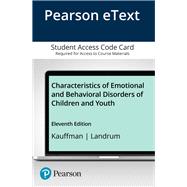Examining emotional and behavioral disorders and the challenges they pose for teachers.
Characteristics of Emotional and Behavioral Disorders of Children and Youth provides a comprehensive view of emotional and behavioral disorders (EBD) and related challenges for students with EBD and their teachers. Case studies and reflective activities help you think critically about behavior and its contexts.
For courses in Characteristics of Emotional and Behavioral Disorders.
Pearson eText is an easy-to-use digital textbook that you can purchase on your own or instructors can assign for their course. The mobile app lets you keep on learning, no matter where your day takes you, even offline. You can also add highlights, bookmarks, and notes in your Pearson eText to study how you like.
NOTE: This ISBN is for the Pearson eText access card. Pearson eText is a fully digital delivery of Pearson content. Before purchasing, check that you have the correct ISBN. To register for and use Pearson eText, you may also need a course invite link, which your instructor will provide. Follow the instructions provided on the access card to learn more.










